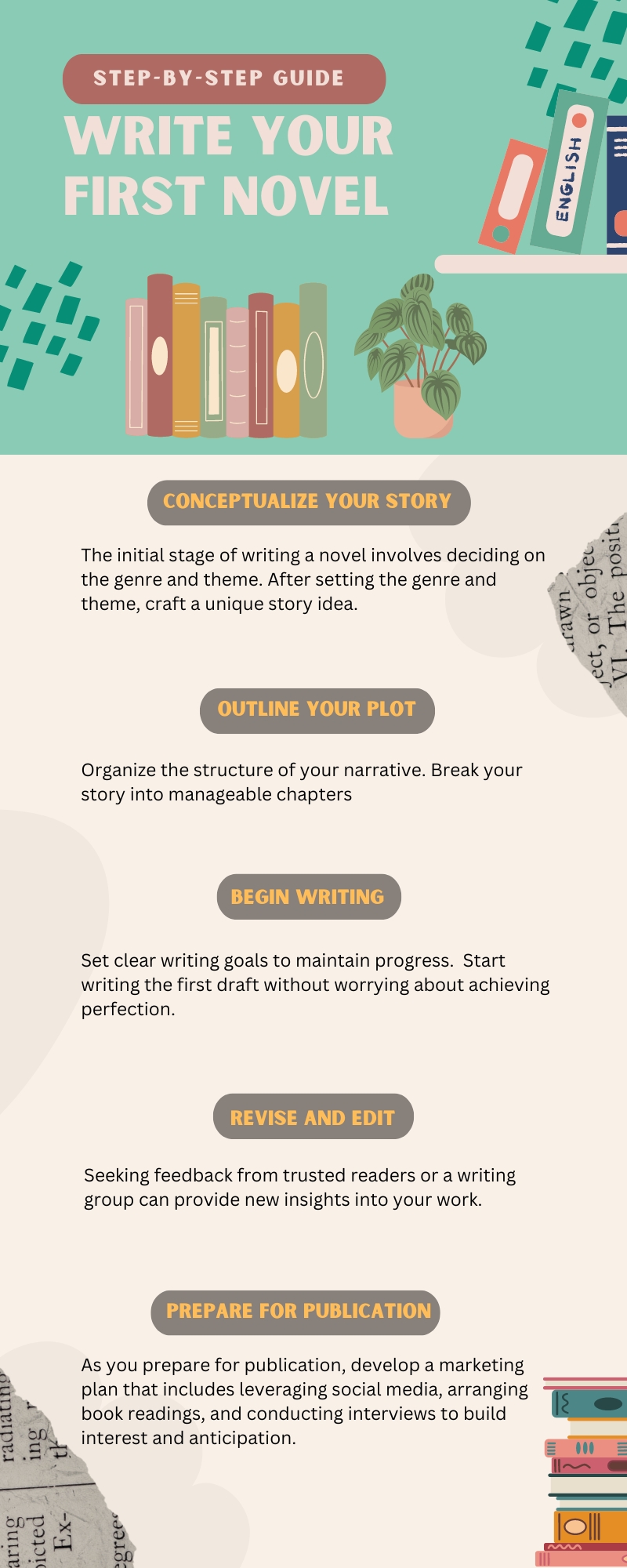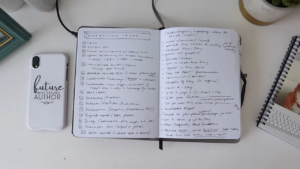Starting your first novel can feel overwhelming, like attempting to build a home without experience in construction. You have visions of what you want to create, but it’s unclear where to begin. As someone who studied literature in school, I understand those feelings well – the eager anticipation mixed with uncertainty about shaping concepts into a complete novel.
This guide aims to make the process less daunting.

Step 1: Conceptualize Your Story
At this initial stage of writing a novel, it’s important to consider the overall atmosphere you hope to create. Choose a realm, like romance, suspense or science fiction, that matches your interests and strengths as a storyteller. This selection will shape both the tone and flow of your work. The core subject, be it love, justice, exploration or survival, acts as the foundation around which your narrative revolves.
Once you’ve defined these parameters, craft a compelling central idea that brings your theme to life through multidimensional characters and plot. This involves imagining a scenario filled with people whose experiences will propel the story forward in a way that expresses what matters most to you. Researching widely in your selected genre also gives useful perspective – insights into approaches that have resonated with others, helping you tell your truth with authenticity and care.
Step 2: Outline Your Plot
Organize the overall structure of your narrative journey. A time-tested approach divides the tale into three phases: the opening establishes the characters and sets the initial conflict in motion; the middle builds intensity with ensuing challenges and related personal journeys, enriching the overall message; resolution brings closure to central questions while tying up loose ends.
Next, paint vibrant portraits of those you’ll accompany on this journey. Craft comprehensive profiles exploring each character’s motivations, history and connections to deepen their humanity. Concurrently, envision how settings might enhance and complement the evolving mood and themes.
Planning by chapters is another key factor. Map sections to guide readers along your tale’s unfolding in a natural flow. Outline highlights of each checkpoint to maintain coherence as new insights and turns arise.
Step 3: Begin Writing

Establish realistic daily or weekly milestones for progress and commit regular windows for focused creativity to cultivate steadiness and forward motion.
Embark on your initial draft with the goal of recording fundamental story bones – for now set aside drives for flawlessness. Let characters and events unfold organically during this exploratory phase, as flexibility often breeds unexpected insights.
This stage invites experimentation as your nascent visions take shape. Have faith that answers will emerge in time through your authentic expression. Steady, small steps transport us farther than we imagine.
Step 4: Revise and Edit

Once your initial story draft is complete, set it aside for a period of rest before reviewing with fresh eyes. Self-reflect by examining the narrative flow for discrepancies, opportunities to enhance character richness, and ways to empower your core message. Peer guidance from trusted companions or writing circles can offer outside viewpoints to advance your work.
Open your mind to respectful commentary – feedback exists solely to support your craft. Refinements at this stage help your audience connect fully. If needed, consider the insights of professional editors who dedicate their craft to developmental feedback. Their perspective could strengthen structure and character authenticity, bringing your story to its fullest realization.
Step 5: Prepare for Publication

Consider traditional publishers’ opportunities alongside self-publishing’s freedoms. If pursuing the former, investigate qualified representatives and discuss their priorities. Self-publishing deserves diligence too – compare platforms and their methods to find the best fit for your goals.
At this pivotal stage, incorporate all input into your final manuscript. Ensure your story shines in the most authentic form while meeting sharing standards.
With publication approaches come ways to share your gift. Craft a sustained, community-focused plan embracing diverse voices – virtual connections, story celebrations, thoughtful discussions introduce new souls to your radiant work. A captivating cover and evocative description stir initial curiosity, yet your work’s heart will resonate.
Obstacles You Might Encounter (And How To Overcome Them)
All creative works will encounter obstacles along the journey. With persistence and community support, these challenges can be overcome.
Consistency
Sustaining a writing routine amid life’s busyness requires flexibility. Set targets tailored to availability. Dedicating a small amount of time daily can establish a helpful habit. Designating a dedicated writing space may also aid focus.
Blockages
Inspiration ebbs at times. Altering surroundings or journaling freely allows the subconscious opportunity to reset. Focusing on the work, not perfectionism, permits exploration without judgment.
Structure
Evaluating narrative coherence involves visualization. Storyboarding introduces an iterative perspective. Collaboration provides useful insight into pacing and logical flow. Diverse perspectives strengthen any work.
Characterization of characters begins beyond page bounds. Understanding characters’ histories and motivations allows empathy to inform complex, nuanced portrayals. External support nurtures this essential work.
Feedback
Receiving commentary requires discernment. Distinguishing an objective evaluation of the work from a personal judgment promotes incorporation of lessons that facilitate growth. A supportive network eases this process.
Refinement
Revisions are divided creatively into bite-sized portions for manageable progress. Tools introduce new vantage points. At times, additional coaching offers knowledge elevating any work to its fullest capacity.
Dissemination
Publication options warrant thorough research to identify the appropriate path aligned with authorial and practical aspirations. Navigating industry realities with patience and guidance cultivates resilience crucial to long-term success.
To wrap things up…
It’s a big step, turning your ideas into a structured story that others can enjoy. Remember, every novelist began with just a vision and the courage to write it down. So keep pushing through the challenges and revisions.
Writing has a lot of ups and downs, but the satisfaction of finishing your story is well worth the effort. Stay persistent, keep refining, and take pride in knowing that you’re creating something truly your own.
I’m Anastasia, and I’ve just wrapped up my postgraduate studies in literature. I absolutely love writing books. It’s my way of weaving new worlds and breathing life into the characters that keep me up at night. Literature isn’t just a field of study for me; it’s a canvas where I paint with words. Through my writing, I hope to connect with others who share my love for storytelling and to contribute something meaningful to the literary world.
Related Posts:
- Guide to Get Your Book into Libraries - How to Secure a Spot
- How To Start Branding Yourself As a Writer -…
- How to Write a Romance Novel - Penning Passion
- How to Create a Marketing Plan for Your First Book
- 16 Ways to Describe Emotions Without Making Your…
- How To Increase Your Productivity With A Writing Routine








